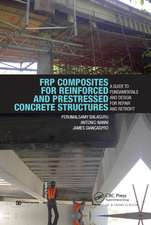Seismic Rehabilitation Methods for Existing Buildings
Autor Reza Mokarram Aydenlouen Limba Engleză Paperback – aug 2020
- Provides a fully functional way to evaluate, model and present details of a seismic rehabilitation plan for a building
- Presents real seismic refurbishment models and step-by-step methods for providing examples (including images, tables and charts)
Preț: 872.74 lei
Preț vechi: 1195.08 lei
-27% Nou
Puncte Express: 1309
Preț estimativ în valută:
166.100€ • 181.97$ • 140.72£
166.100€ • 181.97$ • 140.72£
Carte tipărită la comandă
Livrare economică 16-30 aprilie
Preluare comenzi: 021 569.72.76
Specificații
ISBN-13: 9780128199596
ISBN-10: 0128199598
Pagini: 680
Ilustrații: Approx. 300 illustrations
Dimensiuni: 152 x 229 mm
Greutate: 0.91 kg
Editura: ELSEVIER SCIENCE
ISBN-10: 0128199598
Pagini: 680
Ilustrații: Approx. 300 illustrations
Dimensiuni: 152 x 229 mm
Greutate: 0.91 kg
Editura: ELSEVIER SCIENCE
Cuprins
Chapter 1: Understanding the basic concepts for Seismic Rehabilitation
1.1 Introduction
1.2 What is seismic rehabilitation?
1.3 Various Type of Buildings and Their Constituent Elements
1.4 Main indicators and criteria for seismic rehabilitation
1.5 Identification of site specifications to investigate threats during seismic rehabilitation
1.6 Chapter at the glance
Chapter 2: What is the seismic rehabilitation? Introduction practical method for seismic rehabilitation of existing building
2.1 Seismic rehabilitation studies with applied approach
2.2 How to determine the strength of materials available in existing building
2.3 Methods of determining the vulnerability of existing buildings
2.4 Methodology for developing seismic rehabilitation strategies
2.5 Chapter at the glance
Chapter 3: Detailed introduction seismic rehabilitation for types of existing buildings
3.1. Masonry Structure Buildings
3.2. Concrete Structure Frame buildings
3.3. Steel Structure Frame buildings
Chapter 4: Detail introduction seismic rehabilitation for Types of non-structural components
4.1 Introducing types of non-structural components
4.2 Understanding potential damage
4.3 Rapid Vulnerability Assessment methods for non-structure components
4.4 Comprehensive assessment of vulnerabilities methods for analyzing non-structural component
4.5 Details of Acceptance Criteria for Non-Structural Based on Seismic rehabilitation objective
4.6 Common Methods for Seismic rehabilitation and reducing danger of nonstructural components
4.7 Case study example
4.8 Chapter at the glance
Chapter 5: Site pathology and seismic rehabilitation method
5.1 Introduction of site effective of building performance level
5.2 Understanding potential damage of site treatment
5.3 One method of rapid Vulnerability for soil bearing capacity
5.4 Comprehensive assessment of vulnerabilities for defining soil-bearing capacity
5.5 Seismic Rehabilitation methods for soil of site
5.6 Practical example of site seismic rehabilitation and Identify potential damage
5.7 Chapter at the glance
Chapter 6: Seismic rehabilitation step’s info-graph for
1.1 Introduction
1.2 What is seismic rehabilitation?
1.3 Various Type of Buildings and Their Constituent Elements
1.4 Main indicators and criteria for seismic rehabilitation
1.5 Identification of site specifications to investigate threats during seismic rehabilitation
1.6 Chapter at the glance
Chapter 2: What is the seismic rehabilitation? Introduction practical method for seismic rehabilitation of existing building
2.1 Seismic rehabilitation studies with applied approach
2.2 How to determine the strength of materials available in existing building
2.3 Methods of determining the vulnerability of existing buildings
2.4 Methodology for developing seismic rehabilitation strategies
2.5 Chapter at the glance
Chapter 3: Detailed introduction seismic rehabilitation for types of existing buildings
3.1. Masonry Structure Buildings
3.2. Concrete Structure Frame buildings
3.3. Steel Structure Frame buildings
Chapter 4: Detail introduction seismic rehabilitation for Types of non-structural components
4.1 Introducing types of non-structural components
4.2 Understanding potential damage
4.3 Rapid Vulnerability Assessment methods for non-structure components
4.4 Comprehensive assessment of vulnerabilities methods for analyzing non-structural component
4.5 Details of Acceptance Criteria for Non-Structural Based on Seismic rehabilitation objective
4.6 Common Methods for Seismic rehabilitation and reducing danger of nonstructural components
4.7 Case study example
4.8 Chapter at the glance
Chapter 5: Site pathology and seismic rehabilitation method
5.1 Introduction of site effective of building performance level
5.2 Understanding potential damage of site treatment
5.3 One method of rapid Vulnerability for soil bearing capacity
5.4 Comprehensive assessment of vulnerabilities for defining soil-bearing capacity
5.5 Seismic Rehabilitation methods for soil of site
5.6 Practical example of site seismic rehabilitation and Identify potential damage
5.7 Chapter at the glance
Chapter 6: Seismic rehabilitation step’s info-graph for




















